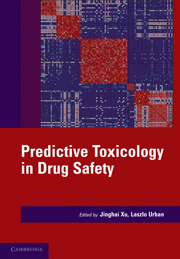Book contents
- Frontmatter
- Contents
- Contributors
- Prologue – Predictive toxicology: a new chapter in drug safety evaluation
- PREDICTIVE TOXICOLOGY IN DRUG SAFETY
- I SPECIFIC AREAS OF PREDICTIVE TOXICOLOGY
- 1 The human predictive value of combined animal toxicity testing: current state and emerging approaches
- 2 Screening approaches for genetic toxicity
- 3 Cardiac safety
- 4 Predicting drug-induced liver injury: safer patients or safer drugs?
- 5 In vitro evaluation of metabolic drug–drug interactions
- 6 Reliability of reactive metabolite and covalent binding assessments in prediction of idiosyncratic drug toxicity
- 7 Immunotoxicity: technologies for predicting immune stimulation, a focus on nucleic acids and haptens
- 8 Predictive models for neurotoxicity assessment
- 9 De-risking developmental toxicity-mediated drug attrition in the pharmaceutical industry
- II INTEGRATED APPROACHES OF PREDICTIVE TOXICOLOGY
- Epilogue
- Index
- Plate section
- References
1 - The human predictive value of combined animal toxicity testing: current state and emerging approaches
from I - SPECIFIC AREAS OF PREDICTIVE TOXICOLOGY
Published online by Cambridge University Press: 06 December 2010
- Frontmatter
- Contents
- Contributors
- Prologue – Predictive toxicology: a new chapter in drug safety evaluation
- PREDICTIVE TOXICOLOGY IN DRUG SAFETY
- I SPECIFIC AREAS OF PREDICTIVE TOXICOLOGY
- 1 The human predictive value of combined animal toxicity testing: current state and emerging approaches
- 2 Screening approaches for genetic toxicity
- 3 Cardiac safety
- 4 Predicting drug-induced liver injury: safer patients or safer drugs?
- 5 In vitro evaluation of metabolic drug–drug interactions
- 6 Reliability of reactive metabolite and covalent binding assessments in prediction of idiosyncratic drug toxicity
- 7 Immunotoxicity: technologies for predicting immune stimulation, a focus on nucleic acids and haptens
- 8 Predictive models for neurotoxicity assessment
- 9 De-risking developmental toxicity-mediated drug attrition in the pharmaceutical industry
- II INTEGRATED APPROACHES OF PREDICTIVE TOXICOLOGY
- Epilogue
- Index
- Plate section
- References
Summary
INTRODUCTION
Pharmaceutical development in the late twentieth and early twenty-first centuries has been a challenging enterprise. It is an expensive undertaking with a high degree of risk associated mainly with a high failure rate. A new chemical entity (NCE) that successfully completes the entire process of drug discovery and development reaching approval as a new therapeutic may accrue total development costs in excess of one billion dollars (U.S.). Also, for the drugs that are successful, it typically takes 10 to 12 years from the initiation of research efforts to reach final marketing approval. Experience in the past decade with the overall success/failure rate process – which now encompasses many new and emerging tools including early screening assays and in silico technologies, and the historical experience of “what works and doesn't work” – has so far not yielded the expected productivity improvements. Enigmatically, recent experience suggests that it is getting more difficult to identify successful lead molecules that lead to safe and effective therapeutics.
A high-level schematic overview of the current drug development process is shown in Figure 1.1. Candidate molecules entering preclinical development from the discovery process proceed through the stages of clinical development (Clinical Phases I, II, and III). During clinical development, safety (first) and efficacy are evaluated in consecutively larger groups of normal volunteers and patients. First-in-human (or FIH) studies number in the 10s of normal subjects or patients, and then the NCE is assessed in patients (100s in Phase 2, and 1,000s in Phase 3) with the disease of therapeutic interest.
- Type
- Chapter
- Information
- Predictive Toxicology in Drug Safety , pp. 1 - 17Publisher: Cambridge University PressPrint publication year: 2010
References
- 1
- Cited by



